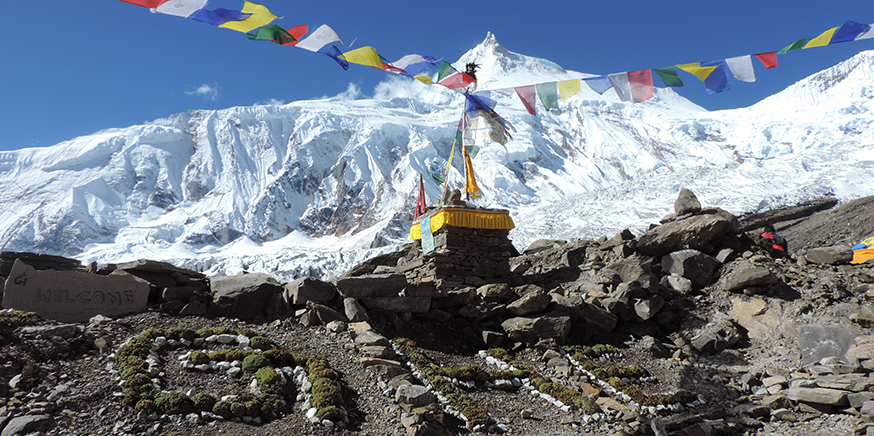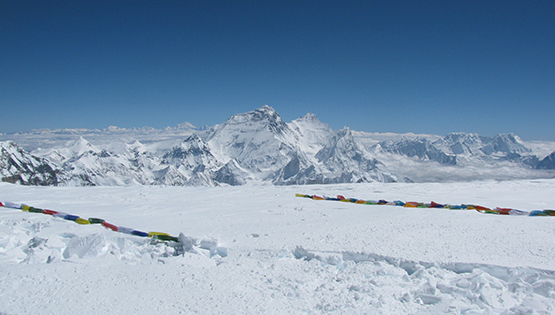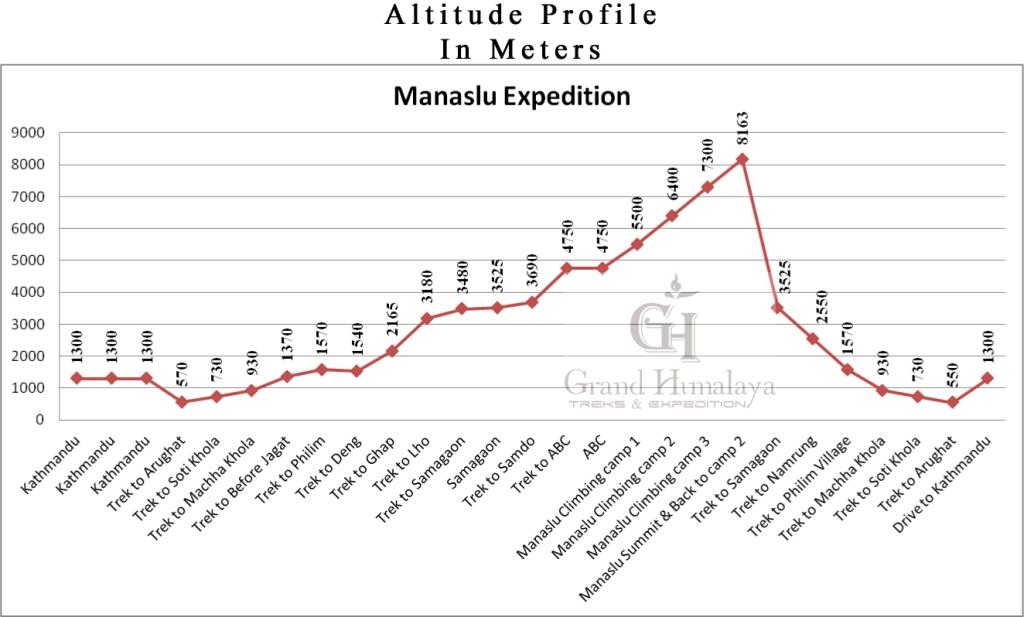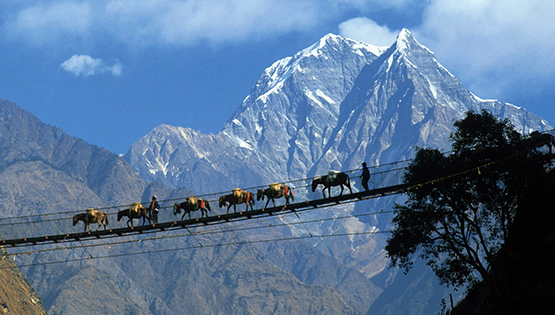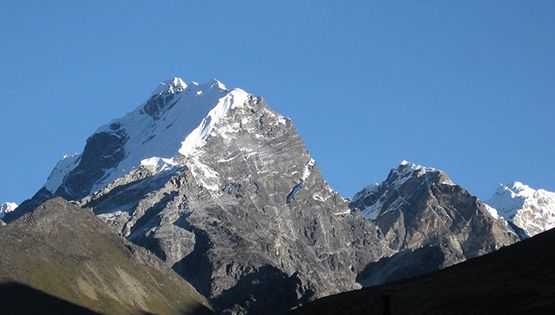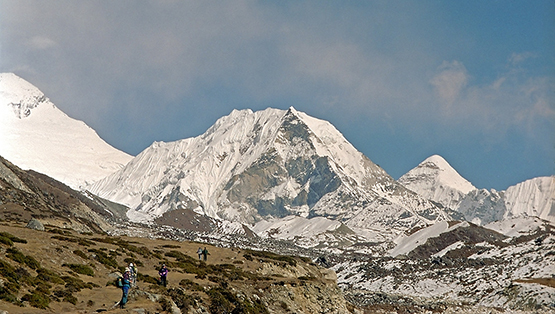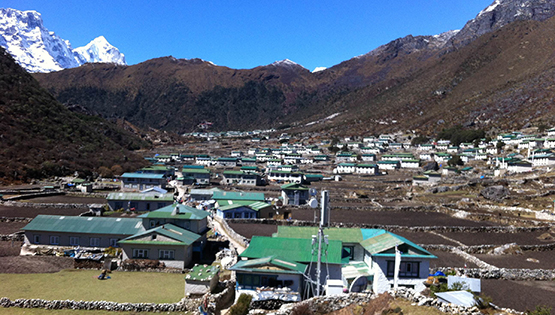Manaslu (8163m), is the eighth highest mountain in the world, and is located in the Mansiri Himal, part of the Nepalese Himalayas, in the west-central part of Nepal. Its name, which means "Mountain of the Spirit", comes from the Sanskrit word Manasa, meaning "intellect" or "soul". This is the same root word of the name of the holy lake Manasarover near Mt kailash in Tibet.
Tibetan people call it as "Kutang l", in which "tang" means the Tibetan word for a flat place thereby describing the mountain's general summit.
Manaslu is one of the coveted 8000m peaks and is a serrated "wall of snow and ice hanging in the sky". The three sides of the mountain fall in steps to terraces down below, which are sparsely inhabited with agricultural operations practiced on the land.
It is considered an achievable 8000m peak with minimal objective hazards and the climbing route follows a relatively straightforward line to the summit without any significant technical sections.
Apart from climbing Manaslu, trekking is popular in this mountain region, as part of the Manaslu Circuit, a notable path by trekkers in Nepal.
There exist half a dozen different routes on Manaslu today of which the south face is the toughest in climbing history.
Manaslu was first climbed in May 9, 1956 by Toshio Imanishi and Gyalzen Norbu, members of a Japanese expedition. It is said that "just as the British consider Everest their mountain, Manaslu has always been a Japanese mountain".
The peak is the best alternative to Mt. Cho-Oyu, with a more diverse landscape and challenging climbing, and very often some mountaineers take it as a better training peak for Mt. Everest than Cho-Oyu.
Reinhold Messier made the fourth ascent of Manaslu as a member of a Tyrolean expedition that climbed the peak from the Marsyangdi valley in 1972, right after the second successful Japanese expedition in 1971 followed by South Korean expedition. Grand Himalayas Manaslu Expedition 2023 autumn team helicopters in and out from Samagaon, a 30-40 minute flight from Kathmandu allowing you to start and maximize your real acclimatization from 3520m. We don’t waste time on the very humid, wet and exhausting trek from Arughat at only 600m during the monsoon season with its free leeches!. The helicopter allows you to maximize the summit weather window on the mountain by giving you up to plus/minus EIGHT more summit days compared to those who operate low cost for 44+ days expeditions from Arughat. If you prefer to trek from Arughat this can be arranged but will increase our trip duration by several more days. We climb the classic North East face of Manaslu via four camps utilizing the support of a regular team of climbing Sherpa’s who carry all group equipment and oxygen. Grand Himalaya provides a fully supported Manaslu expedition at a very competitive price and we don’t use phrases “you may need to carry your own oxygen up and down the mountain”. The climbing route is fairly direct with the steepest sections through the serac field between Camp 1 and Camp 2, however these sections are not sustained. The other technical difficulties are found on the ice cliffs/seracs we weave through on the approach to Camp 4 and the final snow arête to the summit. Manaslu summit day as normal in the high mountains starts very early and should take about 6-8hrs. The climbing starts quite easily before steepening where fixed lines need to be utilized. The climb passes the false summit and finishes on an exposed ridge that takes you to the true summit a journey of 150m height gain.
Email us for the detailed trip notes and climbing gear list at namgyasherpa.grandhimalayatrek@gmail.com
A very warm welcome to the Kingdom of Himalayas. Upon your arrival at the Tribhuvan international airport our representative welcomes you and assists you transfer in your hotel in Kathmandu. After time to get refreshed, evening you'll meet and transfer for welcome dinner in one of the typical Nepalese restaurant in the heart of Kathmandu i.e. Utsav or Nepali Chula (Kitchen). Here you will not simply experience the traditional Nepalese dish but will be entertained with Nepalese traditional dance and folk songs. After the dinner, tonight you will also get introduced with fellow expedition members and guides. You will be transferred back to your respective hotel after dinner.
Preparation for Expedition; the expedition leader has to attend a formal briefing in the Ministry of Tourism. The day will also be for finalizing official procedure and other necessary arrangements. You will be also briefed on the nature of expedition, equipment and team composition. Your guide will conduct a gear check and you can finalise the packing of your climbing duffel that will go ahead for transport to Base Camp. It is the last opportunity to buy any missing items in Kathmandu that are an essential for the climb. There are several outdoor shops in the town, consult your guide. Overnight at Hotel.
Kathmandu is the historical and cultural heart of Nepal and has been a popular destination for tourists ever since Nepal opened its doors to visitors. The city presents a wonderful mix of Hinduism, Tibetan Buddhism and Western influence in the Valley. Bauddhanath: Stupa with its 130 ft. dome. One of the world's largest Stupa, Bouddha is generally acknowledged to be the most important Tibetan Buddhist monument outside Tibet. Pupshupatinath Temple: Pashupatinath is considered one of the holiest shrines of all the Hindu temples. The temple has remained the presiding deity of ruling Nepalese Royalty. Swayambhunath: Three kilometers west of Kathmandu city complex locates the one of the world's most glorious Buddhist Stupas, it is said to be 2000 years old. Visitors often call it "Monkey Temple". Overnight at Hotel.
After breakfast we will be departing hotel for domestic airport in Kathmandu, flying in a helicopter on a clear day gives one the thrill of catching an incredible panoramic view of the snow-capped mountains that stretch from east to west of Nepal's boundary with Tibet. The changing landscape from the icy Himalaya in the north to the rich green Mahabharat range to the south and the sweltering sub-tropical jungles in the plains make this flight fascinating. Depending on weather and wind direction, the flight may take 30-40 minutes each direction.
Depending on personal physical condition, we may have to be mellow or stay active during the day, there are several sights we can involved.
Today after breakfast we will hike up to Manaslu base camp, it is a huge altitude gain (1280m)in a single day, there isn't a place to spend the night in between, so have to make it all in one day. Hike will take about 5-7 hours.
These days are the major climbing days for you to ascend the summit of most awaited Mt. Manaslu. After some day’s acclimatization and exercise you will be taken to the higher camps to be closer to the summit of (8,163m) where you will be provided food for high altitude. You are allowed to trek from lower camps to higher camps or vice versa for more practice and acclimatization. Finally we wish for your success to reach in the summit. Here you get full board service with tented camp accommodation in all camps.
Hike down to Samagaon early in the morning to catch the helicopter flight back to Kathmandu, if weather permitting we should be back in Kathmandu before noon to enjoy the rest of the afternoon. Evening farewell dinner.
Today is free or last minute shopping for souvenirs or gift to your family, friends or relatives for you until your departure flight/drive or to commence any extra trips or activities you may have booked with us. If departing, you'll be transferred to the International Airport for your departure flight to your onwards destination.
- Mt. Manaslu climbing permit from North east face (Normal route)
- 4 (Four) night accommodation in Kathmandu. Room on twin sharing basis, breakfast is included.
- All pickup and drop transportation from airport to airport both domestic & international airport and other transportation in the valley.
- Private Transportation Bus KTM-Dharapani-KTM all expedition supplies, Sherpa, guides, L/O and all local camp staff.
- One day guided city sightseeing tour in around Kathmandu according to our itinerary.(Largest Buddhist stupa in the world at Bouddha Nath and the most important Hindu temple in the valley at Pasupati Nath). And Monkey temple at Swayambhunath. With Transportation, fully licensed guide and entry fees included. Extra city sightseeing tour can be arranged on request for additional fee, after the expedition if required.
- All entrance ticket fees for all tourist sites listed on our itinerary.
- Private Truck transportation for expedition supplies KTM-Dharapani-KTM.
- Necessary number of porters and Mules to carry the Expedition loads from Dharapani-MBC-Dharapani.
- Liaison officer fee, Rope fixing fees above BC-SUMMIT.
- Guide/Sirdar (Namgya Sherpa) who has led 18 Everest expeditions and has made 15 successful ascent of Mt. Everest from both North and south side.
- Well trained Cook and kitchen boys at MBC.
- Climbing Sherpa (1:1 ratio) they will be help delivering all group gear, food, tents, oxygen on the mountain and accompanying you on summit day. This will several times multiply your safety and chances on successful summiting.
- All necessary climbing hardware gear, all necessary camping and kitchen equipment.
- Private tent at Base Camp with mattress unless couple wishing to share a tent.
- Well insulated dining tent at BC with gas heaters and solar light inside.
- Toilet & Shower tents at BC.
- Quality high altitude food.
- Altitude tents for higher camps (Tent on sharing between two climbers on the mountain).
- Store & communication tent at BC.
- Necessary number of EPI gas with burner.
- 4 litter capacity new brand SUMMIT Oxygen (4 bottles for each member & 2 for Sherpa).
- New Brand SUMMIT face Mask and Regulator set (Only for use).
- VHF Radio base at BC & one hand held set between two climbers during climbing period
- Solar panel/generator at base camp for recharging & power supply.
- 2 extra bottles of Oxygen with mask set stand by for emergency purpose at Base camp.
- Insurance of all climbing Sherpa, BC crew, L/O and porters. (Coverage of Accidental death/Medical expenses and emergency Helicopter evacuation cost)
- Occasional/Limited alcoholic beverage will be provided at BC only (Imported good quality Red wine available in Kathmandu, Beers, unlimited Soft drinks Coke, Sprite, Mixed flavored caned juice.
- All lodging & meals in houses at Samagaon, Meals can be selected from the menu at local lodges according to individual choice, Breakfast/Lunch/Dinner/all hot drinks.
- Meals 3 times a day at MBC will be prepared by our well trained Nepali chefs in our hygienically maintained Kitchen tent.
- One locally made water proof Duffel bag with your Name & Grand Himalaya's Logo on it will be provided by us for the Trek up to BC & back to KTM; it is yours so you may take it back to home with you or return to us at the end of trip.
- Celebration meal in Kathmandu after the expedition with all the local staffs.
- Manaslu Base Camp biodegradable and non-biodegradable garbage disposal fee to the Manaslu Region Pollution Control Committee (MRPCC).
- A regular/simple cell phone with local SIM Card & charger cable will be provided in the team during the trip. Guest will be requested to return this to Grand Himalaya staff at the end of the trip. Or each member will get one Local Phone SIM Card.
- Your International & home country domestic airfares, transfers en route & excess baggage
- Your personal insurance. Medical, mountain rescue & repatriation cover is obligatory.
- Your personal expenses e. g phone calls, laundry, alcoholic beverage, mineral water, charges for Showers, electronic device charging facility is available in tea house at Samagaon for additional fee on hourly basis & Wi-Fi.
- Main meals (Lunch & Dinner) in Kathmandu (Allow up to $12-15 per meal) apart from celebration meal in Kathmandu after the expedition.
- Your Nepal entry visa fee (USD $125 available on entry) Valid for 90 days & it is your responsibility to obtain your visa before departing home for the trip.
- Your personal climbing gear according to the gear list we will be providing one your book this trip with us.
- Satellite phone usage is available, but at an additional cost for personal use.
- Extra night accommodation in Kathmandu because of early arrival, late departure, early returning from mountain (due to any reason) than the scheduled itinerary.
- Cost of electronic appliances.
- Summit bonus for your personal climbing Sherpa (Minimum is $1000--1200 per Sherpa)(Bring in cash to pay your Sherpa directly at MBC after summit)
- Tipping to the guide & local staff (allow up to $450 per guest)
- All guests are kindly requested to bring your own First Aid Kit with sufficient medication supplies for expedition period.
- Applicable permit fees & customs charges, etc for SAT Phone, communication equipment and commercial Filming Permission Fees. Need to inform us early in advance for issuing necessary permit.
| # | Start Date | End Date | Trip Cost | Availability | Booking |
|---|---|---|---|---|---|
| 1 | 5 Sep 2024 | 8 Oct 2024 | USD19,800/Per Climber | Available | Book Now |
A non-refundable booking deposit of USD6500/climber is payable at the time of booking and the final balance due 8 weeks before the start of the trip from Kathmandu. The act of booking implies that you have accepted the ethos of the trip and any objective or subjective risks associated with it.
